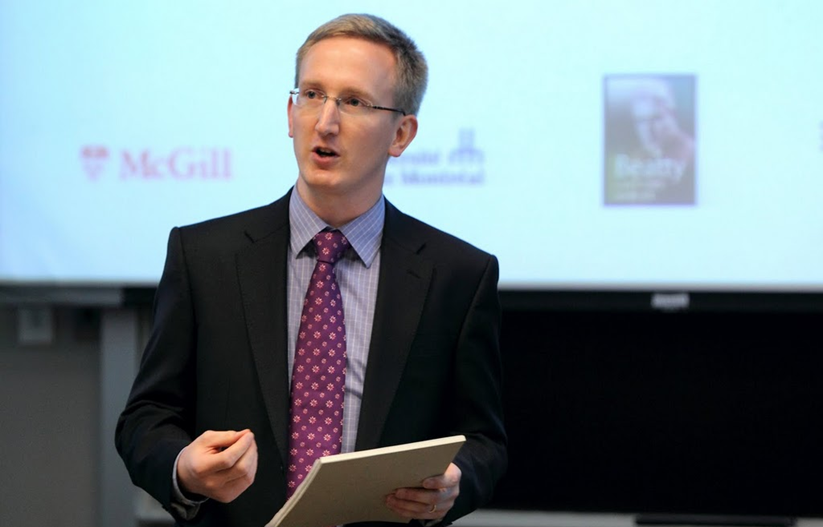by David Higgins
Romantic Textualities 15 (Winter 2005)

McGill Reporter – October 2005
View as HTML (English)
View as HTML (French)
In high school, Tom Mole carried about Byron’s “Don Juan” like a dandy’s gold-topped cane. “I thought it was the funniest, most brilliantly written poem I’d ever come across,” says Mole, in his office in the Department of English.
The London-born Mole, the first in his immediate family to go to university, always assumed he’d study Lord Byron (1788-1824) in depth, but it wasn’t until his graduate studies at the University of Bristol that he seriously cracked the book spines of the Romantic-era wit. A more mature look at the poet led Mole to thinking less about Byron’s product and more about the product of Byron.
Byron enjoyed an unprecedented celebrity and fame, previously the domain of those who did great deeds, had high social standing, and were, uh, dead. “Real fame was thought to be posthumous fame,” says Mole, but Byron was enormously popular while he was alive — his poem “The Corsair” sold 10,000 copies in one day.
It’s not that Byron was the David Bowie of his generation, but that a range of emerging social factors and technologies set up the conditions for Byron’s celebrity.
There was increasing literacy among the masses, who were sufficiently leisured and sufficiently moneyed to buy and read poems, and a better infrastructure for getting books and pictures to people.
As well, his image was marketed vigorously, Mole says, thanks to the portraits Byron commissioned. “They circulated widely in engravings, and every time they’re engraved — there’s no copyright — they change a little bit. Then they start to appear in caricatures and other kinds of graphic satire.” It didn’t take long for pictures that portrayed Byron with an open collar and curling forelock to circulate widely.
Unlike a commissioned painting, anyone can buy an engraved image to possess and “consume” in the privacy of their own home. “What’s key to Byron’s celebrity is the intimacy his readers feel,” Mole says. “When you’re reading a Byron poem, looking at a Byron picture, reading a biographical sketch in the paper, when you’re consuming Byron’s celebrity image, it feels like you’re having a kind of relationship with the poet.”
By drawing the connections between the poetry and his life, Mole says, “each reader believes that they alone are the one who understands Byron.”
Also, with the surge in printed material at the end of the 18th century, writers and readers became less known to each other. Culture needed to find a way for texts to bridge that gap. Byron’s poems avoided the impersonality of mass-produced products by constructing an impression of intimacy.
Byron had a knack for always seeming to reveal something about himself in his work, in a veiled dance of reveal and conceal, Mole says. “He always left the reader something to imagine. And he could always write another poem that could reveal a little bit more — it kept readers coming back.”
Byron was merely one part of a celebrity-making machine, says Mole. “It’s about Byron, his publisher, newspaper journalists, artists, engravers, caricaturists, printers, magazine publishers — a whole cultural apparatus.”
Now that Mole is happily settled in to the “vibrant university culture” at McGill, he wants to tackle the history of celebrity, using Byron as the first case study.
“We’re obsessed with celebrity,” he says, citing the global success of TV’s American Idol and its knock-offs, which purport to uncover people’s inner brilliance or manufacture them into stars. The fantasy is that anyone can become a celebrity (ironically, the program’s format is far more successful than anyone who’s come out of it).
“Celebrity culture has an investment in us not thinking about it, remaining mystified. As long as we attribute the public profile of an individual to their talent or innate star quality, celebrity culture continues to work untrammeled.
“Only by thinking of that history, will we be able to engage critically with celebrity culture now.”

Re:Search Magazine, University of Bristol
Issue 9 (April 2005) – View as HTML Download PDF
 The University is committed to making the results of its research as widely available as possible. As an incentive to encourage more articles, we devised a writing competition with cash prizes. This article by Dr Tom Mole shared third place.
The University is committed to making the results of its research as widely available as possible. As an incentive to encourage more articles, we devised a writing competition with cash prizes. This article by Dr Tom Mole shared third place.
I was in Boston last week for a cultural studies conference, and one of the papers caught my eye. The event had been bursting at the seams with odd poststructuralist analyses of Buffy the Vampire Slayer, but this paper was surely the oddest of the lot. It was called ‘Zsa Zsa Gabor’s Persona as an Aging Celebrity’. I was in Boston to talk about celebrity myself. I’ve spent the last five years investigating the history of celebrity culture – especially the poet Lord Byron – and I was there to tell people what I’ve discovered, but I wanted to take the long view. While Zsa Zsa’s certainly not getting any younger, celebrity culture is even older than her. Two hundred years older, in fact.
Celebrities are everywhere now, but hardly anyone thinks to ask difficult questions about how celebrity culture works, and where it came from. The few who do ask have tended to fix on film, tracing celebrity culture back to the rise of cinema in the early 20th century. I think they’re right to link celebrity to a new technology, but they’ve got the wrong one. As a literary scholar, I can see that the crucial technology was printing, and that the enabling advances took place a century earlier.
Printing and publishing became a full-blown industry at the end of the 18th century. That led to a massive growth in the number of books published and fuelled the rise of newspapers, magazines and advertising. At the same time the audience for those texts expanded as the population grew and more of them learnt to read. In the early days of industrial capitalism, this produced a rich and fascinating print culture. But it also created two new problems.
Firstly, people started to suffer from information overload. Isaac D’Israeli was already swamped by 1795. Since “every literary journal consists of 50 or 60 publications,” he wrote, “when I take the pen and attempt to calculate … the number of volumes which the next century must infallibly produce, … I lose myself among billions, trillions, and quartillions”. At the same time, the percentage of books published anonymously dropped drastically. As more and more named authors jostled for public notice, a personality overload set in. Readers couldn’t possibly keep up. They needed ways to select which texts to read and which to ignore. Secondly, readers and writers started to feel alienated. In the new mass market for books, they could no longer know each other. The audience became a faceless crowd, while the author risked being a distant and impersonal figure. Writers and readers started to feel like estranged producers and consumers in the marketplace.
Celebrity culture emerged to solve – or at least to mitigate – both those problems. In response to the personality overload, it turned the celebrity’s proper name into a brand name. When the European Magazine received a “new volume of poetry, bearing the noble name of Byron as its passport to celebrity” it knew that the noble name guaranteed certain marketable qualities and connotations. Byron cut a figure as an adventurer, lover and aristocrat gifted with roguish charm. His publisher, his reviewers and his engraved portraits all supported that persona and sold tens of thousands of books. As a result, all eyes were on Byron.
Celebrity culture overcame the feeling of alienation by creating a sense of intimacy. The trick was not to let the poems seem like industrial productions competing for attention in a crowded market. Instead, Byron fostered the impression that his poems could only be understood fully by referring to their author’s personality, and that reading them was entering a kind of intimate relationship with him. “They are not felt … as declarations published to the world,” wrote one reviewer, “but almost as secrets whispered to chosen ears.”
It’s been hard for us to see the history of these celebrity strategies because, to a large extent, we live in a culture that’s still shaped by them. But celebrity culture looks increasingly worrying, as it colonises politics, business, and even academia. We won’t understand what fascinates and troubles us about celebrity culture until we understand that it has a history even longer that Zsa Zsa Gabor’s. Uncovering that history has taken me from Byron to Buffy and beyond. It adds to our understanding of the past, but it can also enable us to engage more critically with the present.
Tom’s £100 prize money will contribute to the cost of including illustrations when this work is published as a book. This work was supported by the Leverhulme Trust.
Dr Tom Mole/Department of English